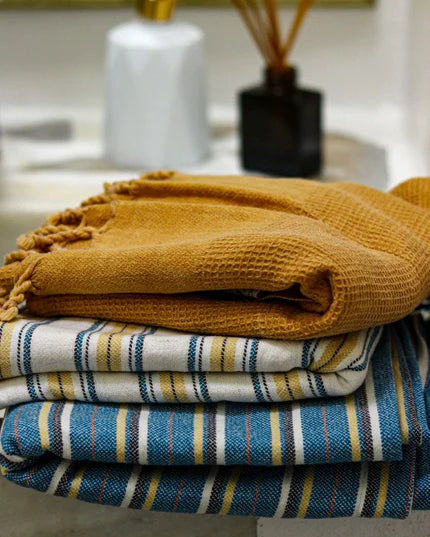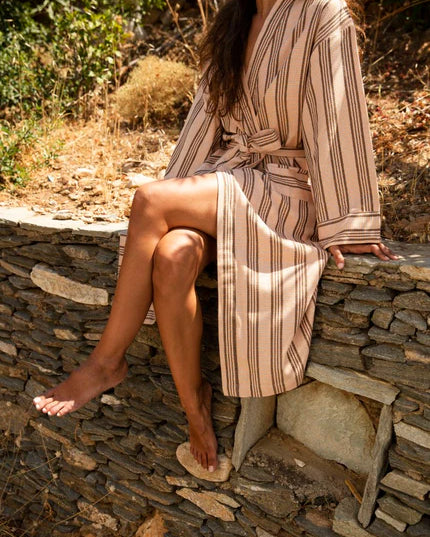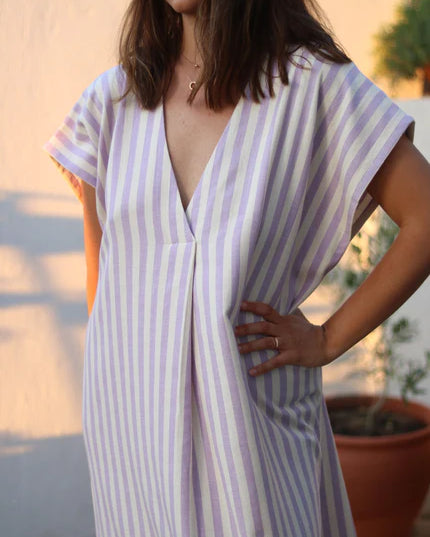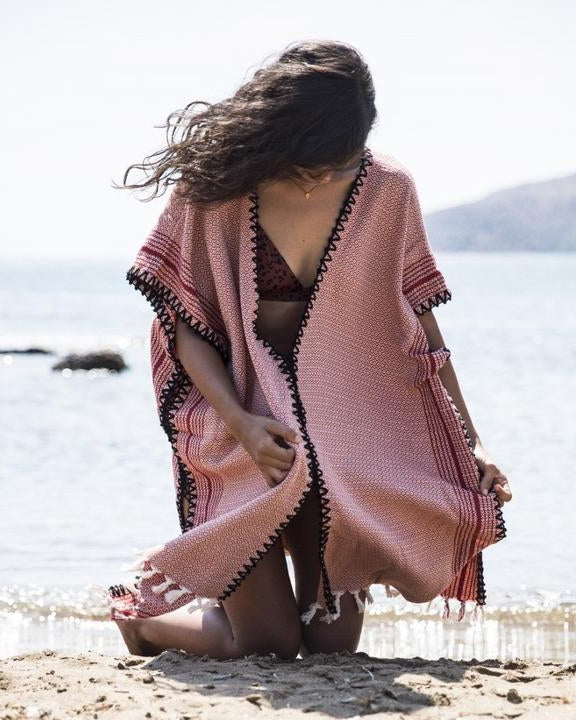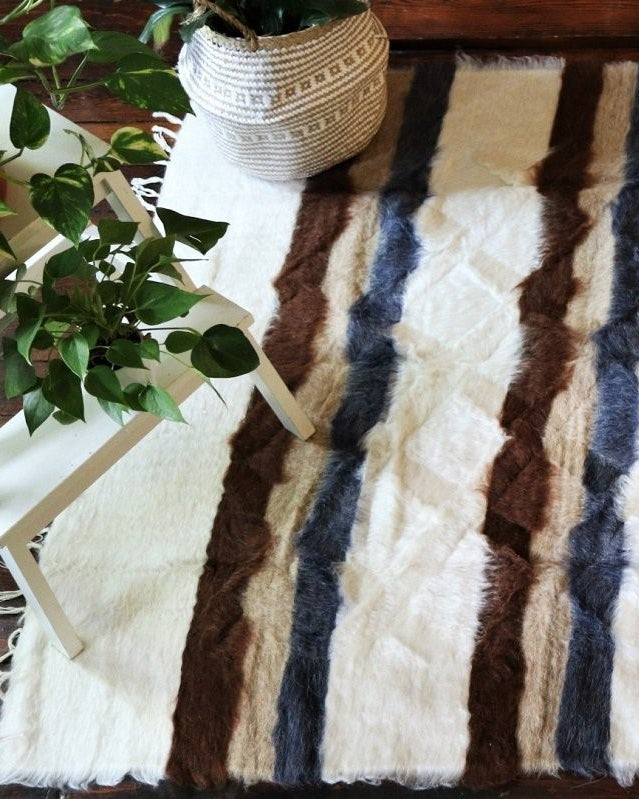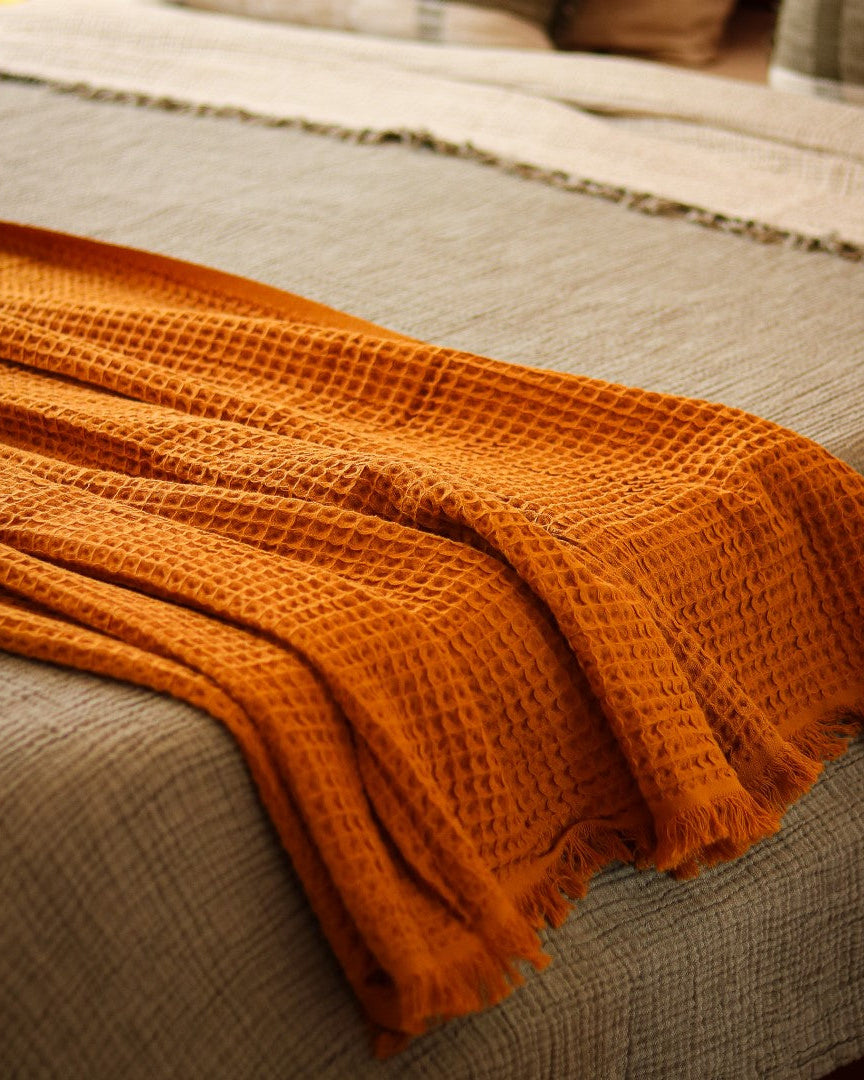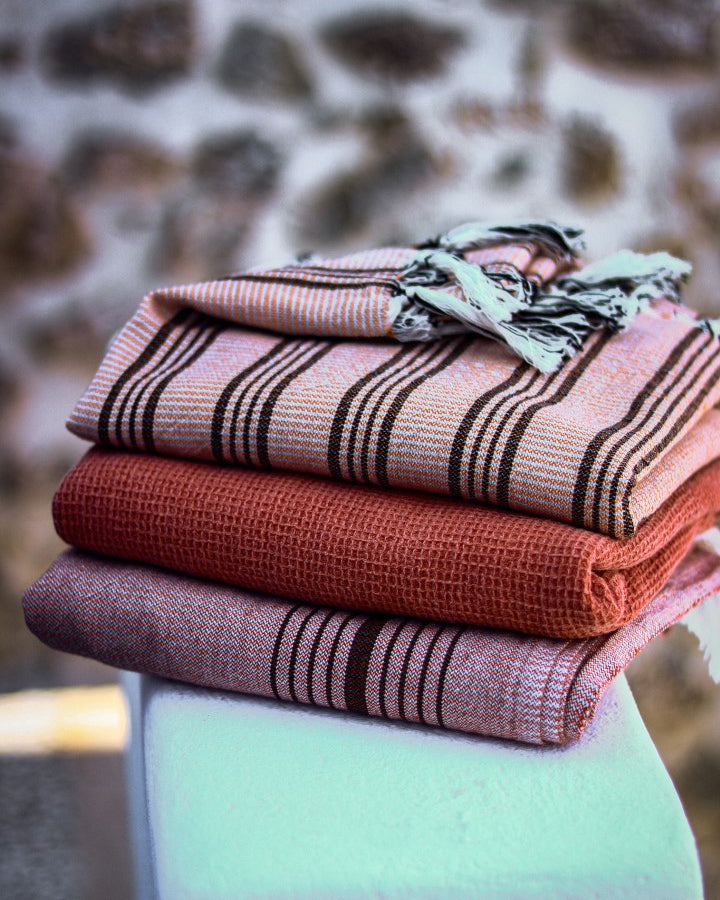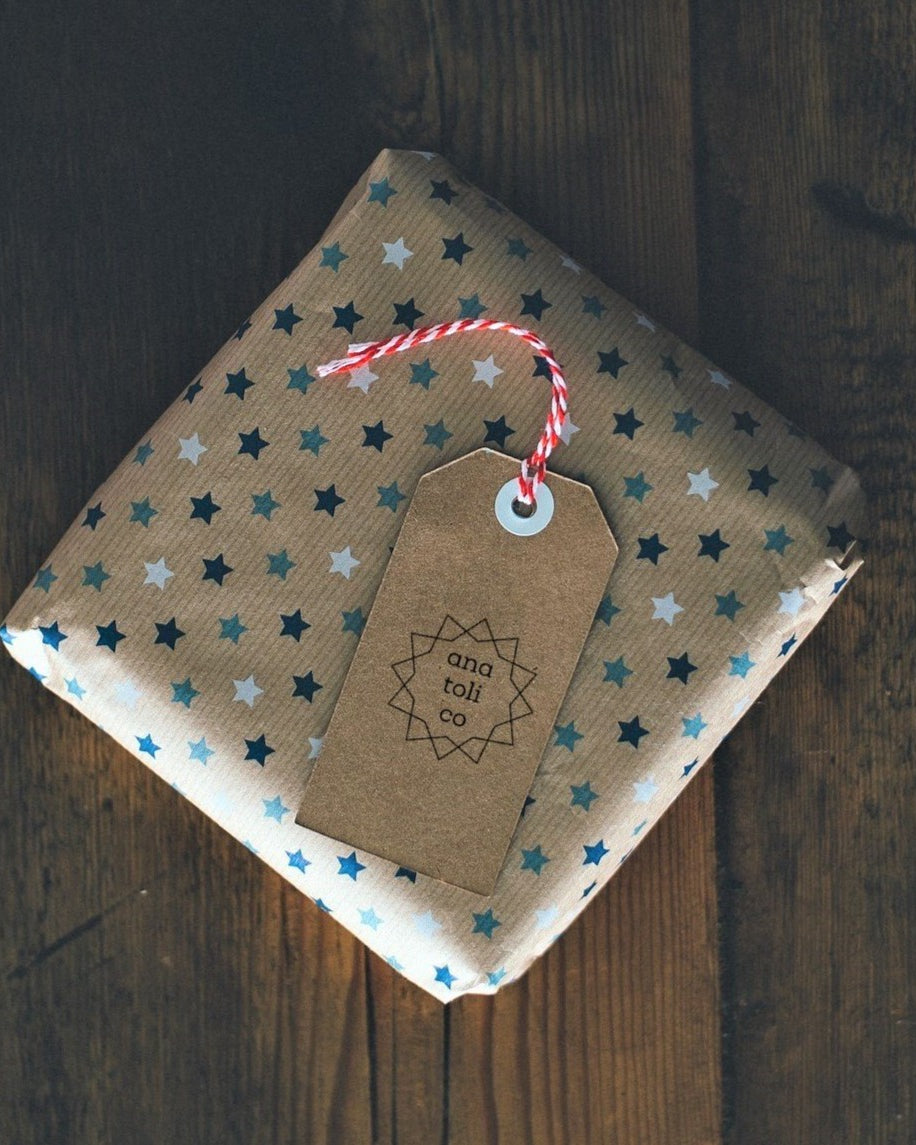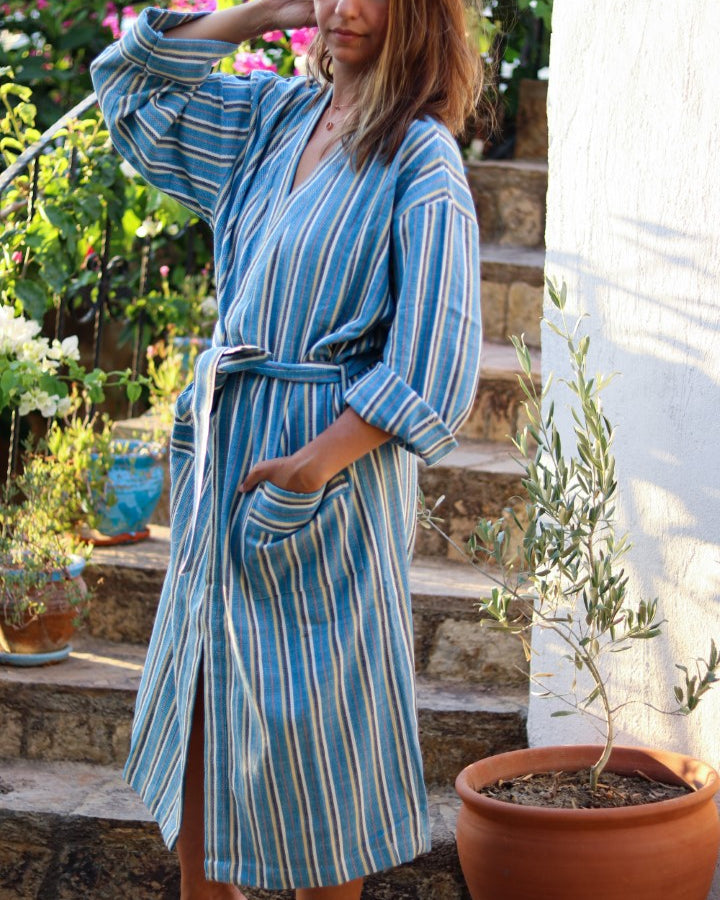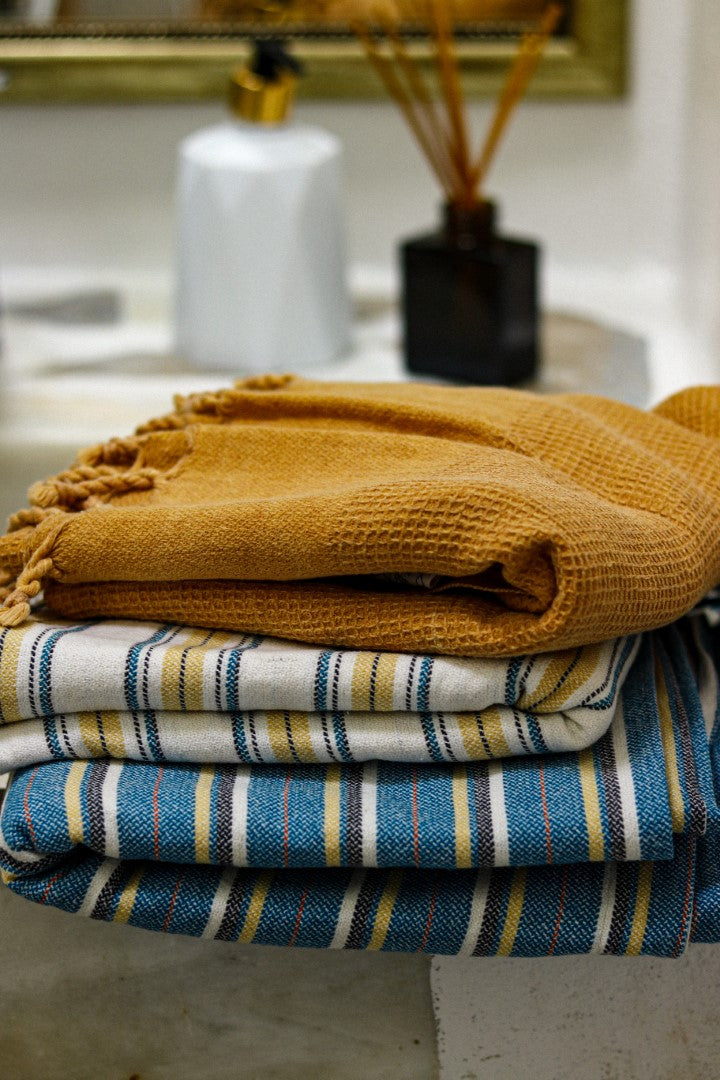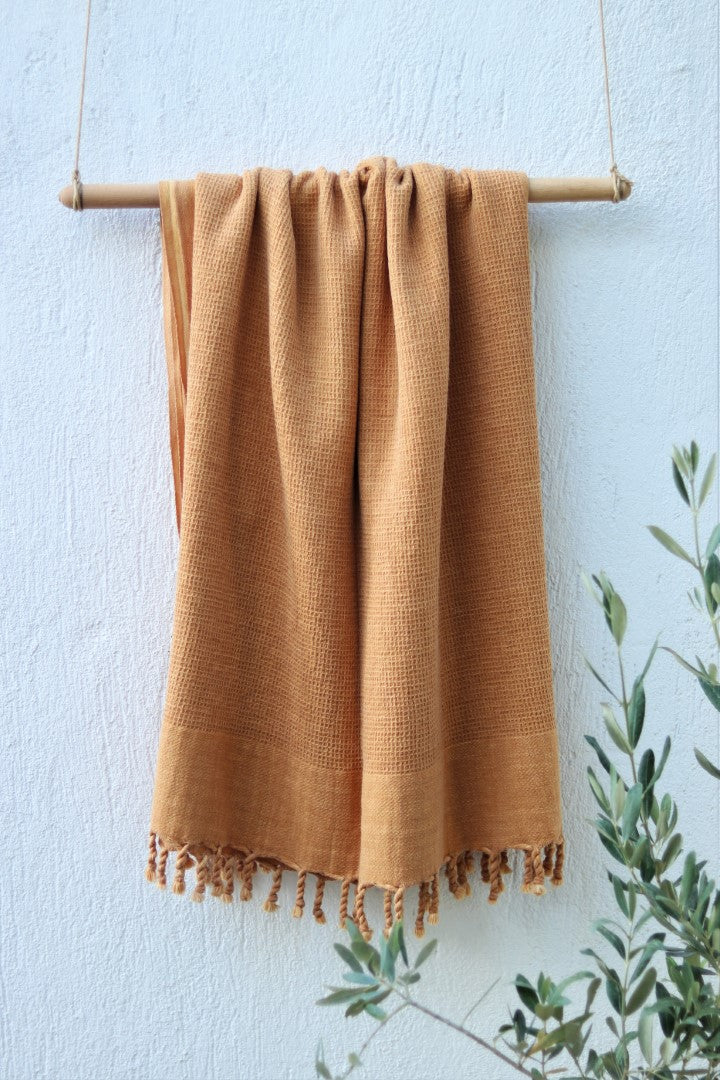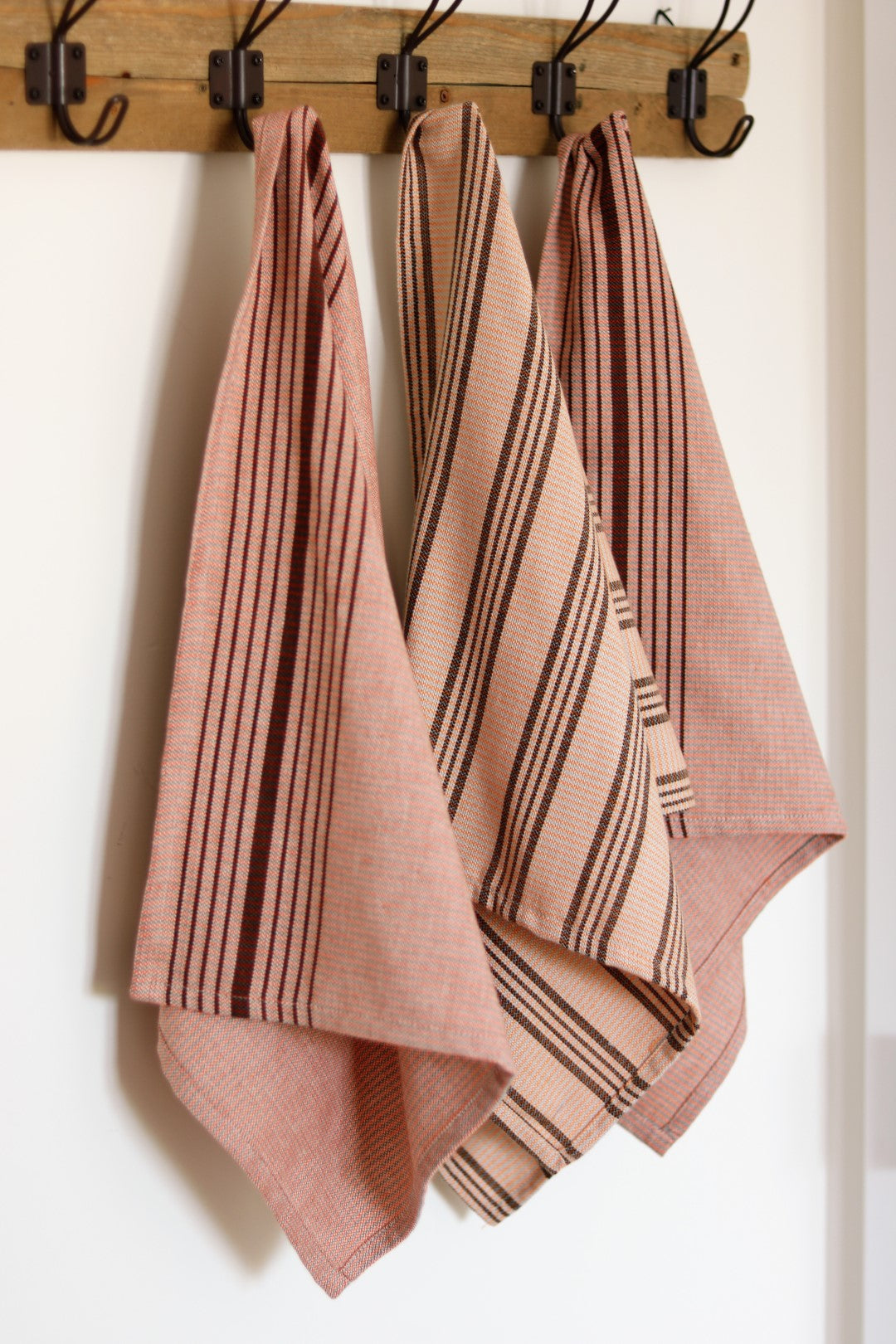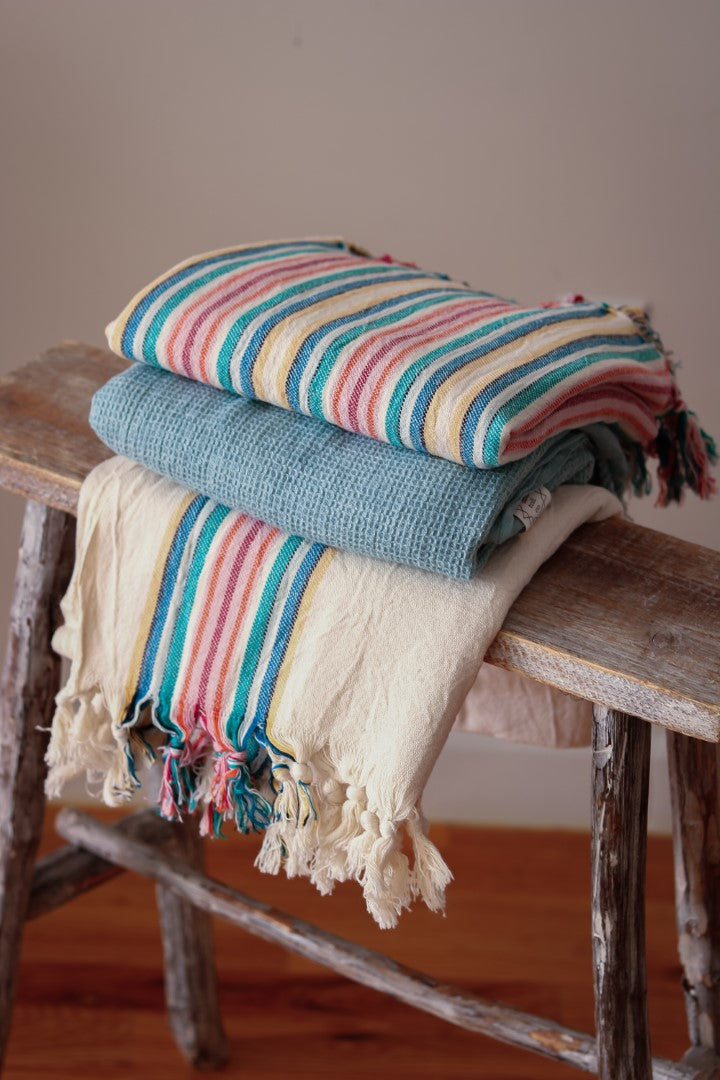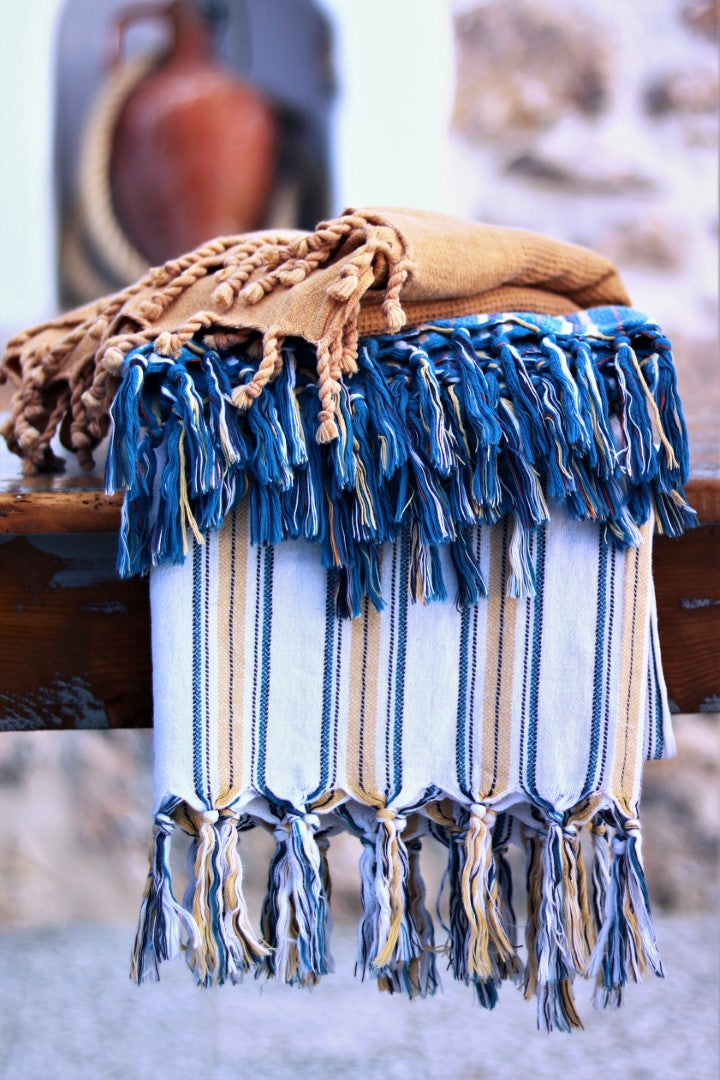When you get right down to it, the Turkish towels vs regular towels debate is all about feel and function. A regular towel gives you that thick, plush, instant absorbency from its heavy terry loops. A Turkish towel, on the other hand, is a lightweight, quick-drying, and incredibly versatile alternative thanks to its flat-woven, long-staple cotton fibers.
The right choice really just depends on what you value more: that cozy, wrap-you-up comfort or a towel built for travel-friendly efficiency.
Your Quick Guide to Choosing the Right Towel
Diving into the world of towels can seem a bit much, but once you understand the core differences, the choice becomes clear. It really all comes down to their construction and the kind of cotton they’re made from.
Turkish towels, also known as peshtemal, have a fascinating history that goes all the way back to 17th-century Turkish baths, or hammams. Unlike the standard looped terry cloth we're all used to, these towels are flat-woven from a special long-staple cotton, which is what gives them their standout qualities.
To really grasp what makes them a premium choice for so many, it’s worth exploring the unique benefits of Turkish towels.
What Makes Them So Different?
The secret is in the cotton fibers themselves. This visual gives you a great idea of the fundamental difference.
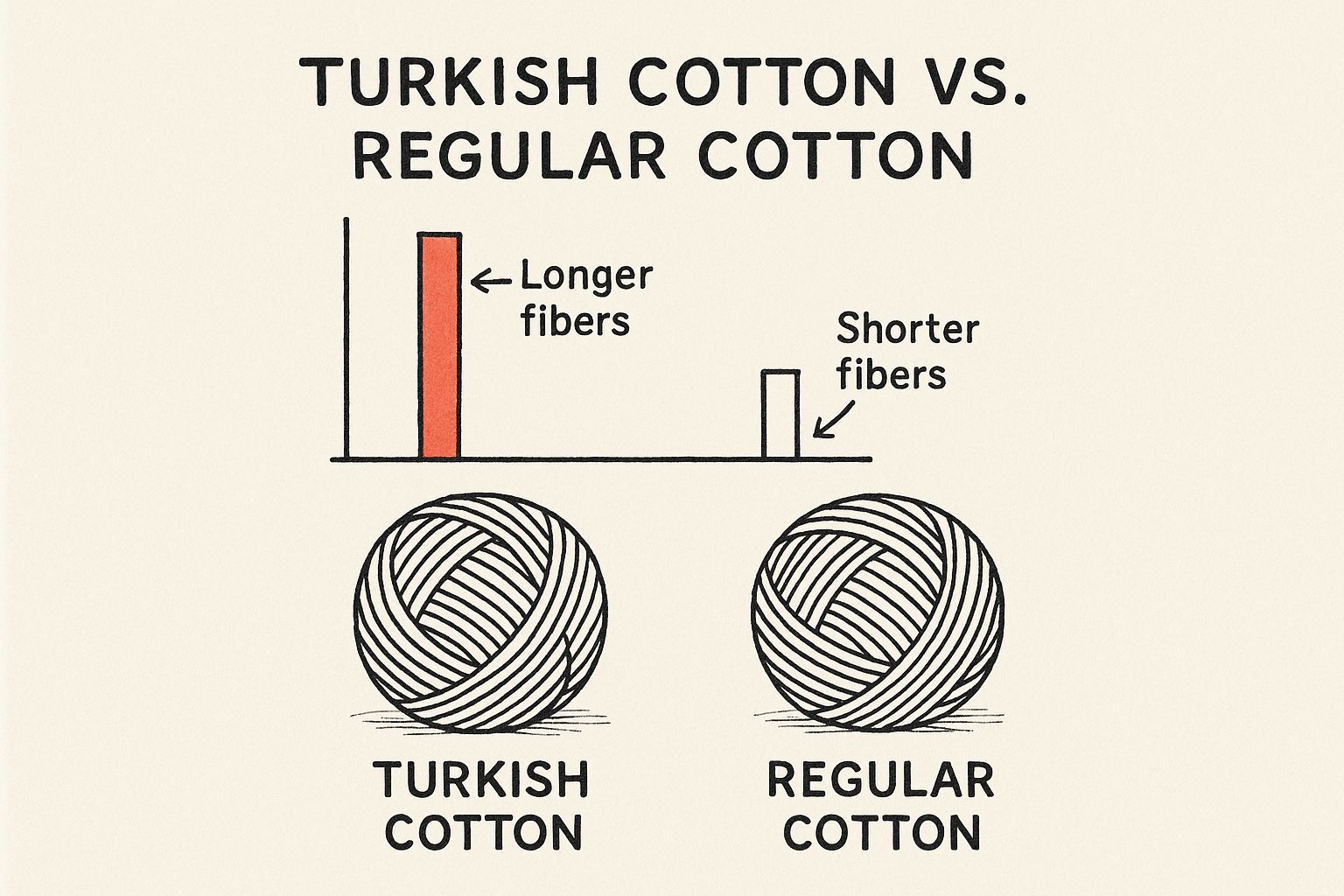
Those longer fibers in Turkish cotton create a yarn that's smoother, stronger, and more durable—the very foundation of the towel's unique character.
Turkish Towels vs Regular Towels at a Glance
For a quick, high-level look, this table breaks down the key distinctions between Turkish peshtemal and standard terry cloth towels. It’s a great starting point for seeing how they stack up in different scenarios.
| Feature | Turkish Towels (Peshtemal) | Regular Towels (Terry Cloth) |
|---|---|---|
| Material | Long-staple Turkish cotton | Standard cotton |
| Weave | Flat-woven, lightweight | Looped terry cloth, plush |
| Absorbency | High, wicks moisture away | Very high, absorbs on contact |
| Drying Time | Very fast | Slow |
| Portability | Excellent; compact and light | Poor; bulky and heavy |
| Durability | High; gets softer over time | Moderate; can become stiff |
| Best For | Travel, beach, gym, humid climates | Home bathrooms, spa-like luxury |
Ultimately, this comparison isn't about which towel is "better," but which one is better for you and your lifestyle.
The Fabric Behind the Feel
To really get to the bottom of the Turkish towels vs. regular towels debate, we have to start with the basics: the cotton and the weave. Everything from how they feel to how they perform comes down to how these towels are made, turning simple threads into a finished product.
The magic of an authentic Turkish towel, or peshtemal, begins with its raw material. They're woven from a premium cotton grown exclusively in Turkey's Aegean Region. This area is famous for its long-staple cotton fibers, which are the secret ingredient behind the towel's unique character. These longer fibers spin into smoother, stronger yarns. If you want to get into the nitty-gritty, you can learn more about the unique properties of Turkish cotton and see what sets it apart.
This high-quality yarn is then woven using a traditional flat-weave technique. Unlike the thick, loopy pile of a standard towel, a peshtemal is flat. This results in a thin, lightweight, yet surprisingly durable fabric.
What About Regular Terry Cloth Towels?
On the other hand, the regular towels most of us have in our linen closets are made from terry cloth. The defining feature of this fabric is its uncut loops, which are deliberately woven to create a huge surface area. Picture thousands of tiny wicks, all designed to soak up and hold onto water.
This construction is exactly what gives a standard towel its familiar plush, fluffy feel and its power to absorb a lot of moisture right away. The cotton is usually a standard short-staple variety. It’s great for creating those dense loops but doesn't have the same built-in smoothness or strength you get from long-staple cotton.
At their core, these towels are engineered for different jobs. A Turkish towel’s flat, tight construction is built for strength and fast drying. A terry cloth towel’s dense, looped pile is built for maximum, instant absorption.
Weave and Fiber: A Head-to-Head Look
Let's break down how these differences in materials and weaving play out in the real world.
-
Turkish Towel (Flat-Weave):
- Fiber: Long-staple Turkish cotton results in a smooth, strong yarn that sheds very little lint.
- Weave: The tight, flat weave creates a towel that's incredibly compact and lightweight. Air flows right through it, which is why it dries in a fraction of the time a terry towel needs.
-
Regular Towel (Terry Cloth):
- Fiber: Standard, shorter-staple cotton is used to create the thirsty loops.
- Weave: Its looped pile is fantastic at soaking up water on contact, but it also traps that moisture, making it heavy when wet and notoriously slow to dry.
This fundamental difference is the starting point for every other comparison. One is built for efficiency and travel, the other for that plush, spa-like comfort.
The Real Difference in Absorbency and Drying Speed
When you’re weighing Turkish towels vs regular towels, the most dramatic differences come down to how they handle water—specifically, absorbency and drying time. It's not a simple case of one being better than the other; they are engineered with completely different philosophies. I like to think of a regular terry towel as a sponge and a Turkish towel as a squeegee. Both get you dry, but they go about it in opposite ways.
A thick, fluffy terry cloth towel is a master of immediate absorption. Its dense, looped pile creates an enormous surface area that’s designed to soak up as much water as possible on first contact. That’s why it feels so satisfying and effective right when you step out of the shower.
But that very strength is also its biggest weakness. Those thirsty loops that trap water so well are reluctant to let it go. This causes the towel to become heavy and waterlogged, making it notoriously slow to dry. In a humid climate or a busy bathroom where towels are used back-to-back, this can be a real problem.
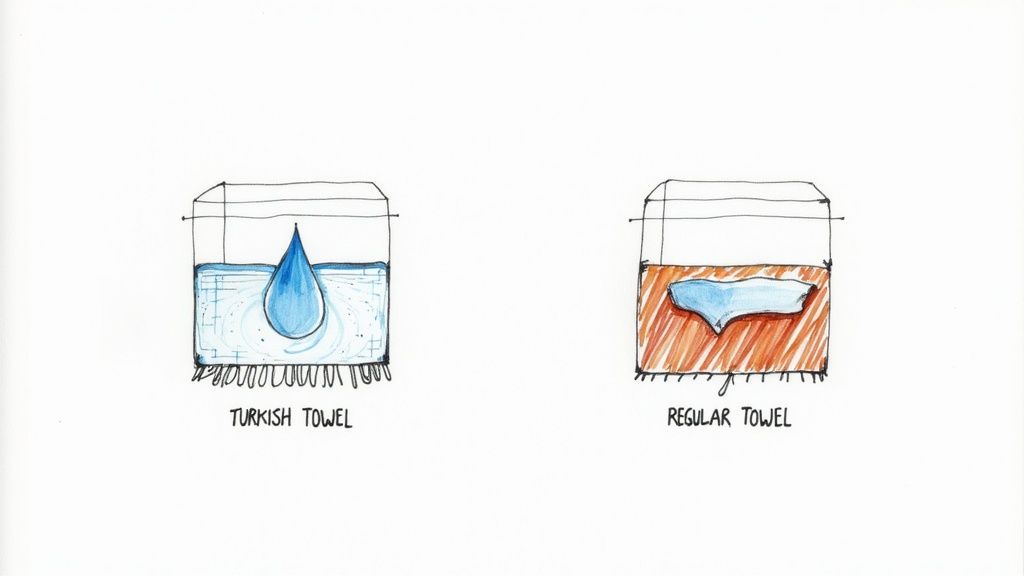
How Turkish Towels Approach Moisture
A Turkish towel, also known as a peshtemal, works on a totally different principle. Its long-staple cotton fibers are flat-woven, a design that isn't meant to trap water but to efficiently wick it away from your skin. It might not have that instant "soaking" feeling of a terry towel, but it gets the job done without becoming a soggy mess.
This wicking action is the secret to its performance. The towel pulls moisture across the surface of its thin fabric, exposing it to the air where it can evaporate incredibly quickly. It’s why a Turkish towel can feel almost dry just an hour or two after use, while a terry towel might still be damp the next morning. This also makes them far less likely to develop that musty, mildew smell that plagues their slower-drying cousins.
The core distinction is this: A regular towel absorbs and holds water, while a Turkish towel wicks and releases it. This simple mechanical difference changes everything from how it feels after use to how long it takes to dry on the rack.
Performance in Real-World Scenarios
So, which one is right for you? It really depends on the situation. Let's look at a few common scenarios where one towel clearly outshines the other.
-
The Family Bathroom: In a house with multiple people showering throughout the day, regular towels can turn into a damp, sad pile. A set of Turkish towels can be a total game-changer, ensuring everyone gets a fresh, dry towel.
-
The Gym Bag or Suitcase: Nothing is worse than packing a wet, bulky terry towel. For travel, the Turkish towel is the undisputed champion. It’s lightweight, folds down to almost nothing, and will be dry and ready for round two in no time.
-
Spa-Like Luxury: Sometimes, you just want to feel pampered. After a long, hot bath, the plush, heavy embrace of a thick terry towel is unbeatable. It offers a sense of cozy comfort that a lightweight Turkish towel just can't match.
It's also worth noting that the principles of fast-drying fabrics extend beyond bath towels. For example, specialized fast-drying hair towels use a similar lightweight, wicking construction to dramatically cut down on hair drying time. Ultimately, your choice boils down to what you value more in your daily routine: plush, absorbent comfort or practical, quick-drying efficiency.
Evaluating Long-Term Durability and Eco-Friendliness
When you're trying to decide between Turkish towels vs regular towels, you have to think beyond the first use. What really matters is long-term value. A towel's durability isn't just about whether it falls apart; it's about how gracefully it handles daily use, endless wash cycles, and the simple passage of time. The secret to a towel's lifespan is woven directly into its fibers.
This is where Turkish towels really pull ahead. They're crafted from long-staple cotton, which produces a yarn that is inherently stronger and smoother. This construction means they're far less likely to pill, fray, or thin out over the years. In fact, something amazing happens with each wash: the fibers tighten up, making the towel even softer and more absorbent. They genuinely get better with age.
Regular terry cloth towels, which are often made with shorter cotton fibers, don't always age as well. Their dense, looped pile is prone to getting snagged or pulled, and after enough time and washing, they can start to feel stiff and lose that initial fluffiness. A top-tier terry towel is definitely built to last, but it rarely improves over time the way its Turkish counterpart does.
The Sustainability Factor
Longevity is one thing, but the environmental footprint of your home essentials is becoming a bigger piece of the puzzle. The conversation is shifting from just what’s best for you to what’s better for the planet, and even small choices can add up.
From an eco-friendly perspective, Turkish towels have a clear advantage because they dry so quickly. Their thin, lightweight weave means they spend far less time—and use far less energy—tumbling around in the dryer. This simple fact adds up to a smaller carbon footprint for your household over the entire life of the towel.
Key Insight: A towel's eco-friendliness isn't just about its material—it's also about the resources it consumes during its lifetime. Faster drying means less energy used per laundry cycle, making Turkish towels a more sustainable choice for daily use.
Making an Eco-Conscious Choice
People are more interested than ever in sustainable products, and it's changing the game for home goods. The global bath towel market, valued at around $11.44 billion in 2024, is expected to grow as more shoppers seek out premium, durable, and eco-friendly textiles. Turkish towels fit perfectly into this trend, meeting the demand for products that are both beautiful and responsible. You can explore more about this growing market on Fortune Business Insights.
Caring for your towels the right way helps them last longer and lightens their environmental load. Here are a few tips that work for both types:
- Skip the Fabric Softener: It leaves a waxy residue on the fibers that kills absorbency. A splash of white vinegar in the rinse cycle is a great natural alternative for stripping buildup.
- Use Cold or Warm Water: Washing in hot water is tough on fibers and can cause them to break down faster, especially with traditional terry cloth.
- Dry on a Low Heat Setting: High heat is the enemy of cotton fibers. Over-drying makes them brittle and weak over time.
Ultimately, choosing the right towel means understanding its entire lifecycle. If you want to go deeper on the material itself, take a look at our guide on how eco-friendly cotton really is. A high-quality Turkish towel is an investment, but it's one that pays you back in incredible durability and a lighter impact on the environment.
How to Choose the Right Towel for Your Lifestyle
Figuring out where you land in the Turkish towels vs regular towels debate really just comes down to your daily life. There isn't a single "best" towel—it’s all about which one fits your routine and what you value most. To make the right call, you have to think past the basic features and picture how each one would work for you in real life.
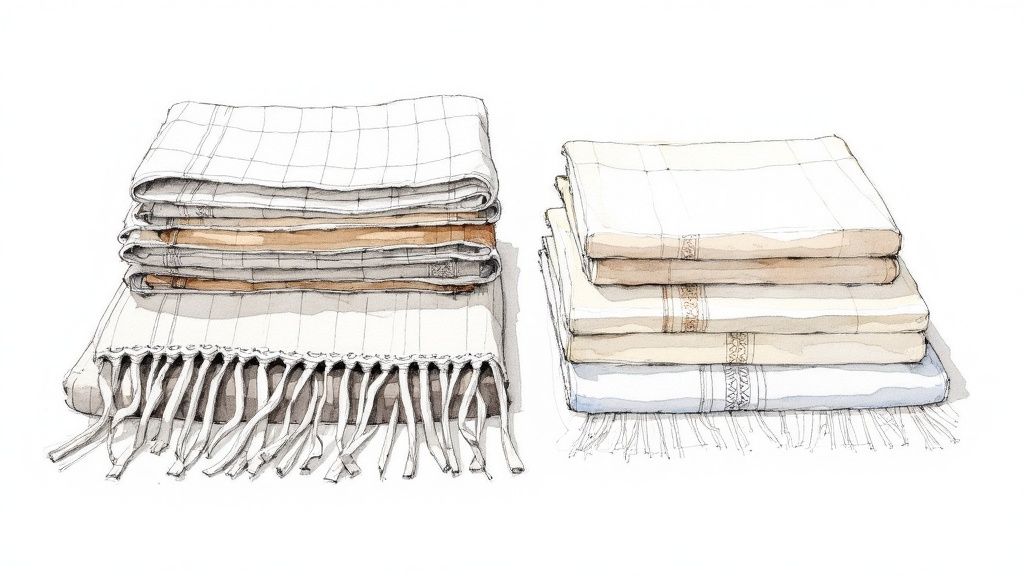
Start by thinking about where you’ll use it most. Are you stuffing it into a gym bag, tossing it in a beach tote, or hanging it in your master bath? Each of those situations demands something different from a towel, and that’s where the right choice becomes obvious.
For anyone who’s constantly on the move, a Turkish towel is a clear winner. Its whole design is built around portability and efficiency, making it the perfect sidekick for an active lifestyle.
When to Choose a Turkish Towel
You'll probably love a Turkish towel if any of these sound like you:
- The Avid Traveler: When you're living out of a suitcase, a big, fluffy terry towel is the last thing you want. A Turkish towel packs down to almost nothing, freeing up precious space for an extra pair of shoes.
- The Beachgoer or Pool Enthusiast: No more lugging a heavy, sopping wet towel home. Turkish towels dry in a flash, and even better, their flat weave means sand shakes right off instead of coming home with you.
- The Gym Member: A peshtemal is perfect for a quick shower after a workout. It gets you dry, then dries itself out quickly, so you don't end up with a musty-smelling gym bag.
- Those in Humid Climates: If you live somewhere sticky where regular towels feel perpetually damp, you'll appreciate how fast a Turkish towel evaporates moisture. It's a simple fix for that never-quite-dry bathroom problem.
When a Regular Towel Is the Right Fit
But let’s be honest, sometimes you just want that thick, plush feeling. In those moments, the classic terry cloth towel is simply unmatched. It’s the go-to when you're prioritizing pure, cozy comfort over practicality.
A regular towel is probably your best bet in these situations:
- The Home Spa Experience: If your favorite part of a bath is wrapping yourself in a thick, warm, absorbent cocoon afterward, nothing beats a high-quality terry towel. It's an everyday luxury.
- Stocking a Guest Bathroom: When you have guests, a set of classic, plush towels is a universally recognized sign of comfort and hospitality. It’s an easy way to make visitors feel taken care of.
- Cold Climate Comfort: On a chilly morning, the sheer weight and dense pile of a regular towel offer a layer of warmth that a lightweight Turkish towel just can't provide.
To help you visualize where each towel shines, here’s a quick guide based on different scenarios.
Best Use Cases for Each Towel Type
This table breaks down which towel is the best fit for common activities, helping you match the towel's strengths to your specific needs.
| Lifestyle / Scenario | Recommended Towel | Why It's the Best Fit |
|---|---|---|
| Frequent Travel & Backpacking | Turkish Towel | Incredibly lightweight and compact, saving valuable luggage space and weight. |
| Beach Days & Pool Trips | Turkish Towel | Dries extremely fast in the sun and repels sand, making cleanup a breeze. |
| Daily Gym Use | Turkish Towel | Lightweight and quick-drying, preventing musty odors in your gym bag. |
| At-Home Spa & Self-Care | Regular Towel | Unbeatable plushness and absorbency provide a luxurious, comforting feel. |
| Guest Bathrooms | Regular Towel | Offers a familiar, five-star hotel feel that pampers your visitors. |
| Family with Young Children | Regular Towel | High absorbency is great for quickly drying off kids after bath time. |
| Living in a Humid Climate | Turkish Towel | Resists mildew and musty smells by drying rapidly, even in damp air. |
| Boating & Camping | Turkish Towel | Takes up minimal space, dries fast on the line, and doubles as a light blanket. |
Ultimately, choosing the right towel is a personal decision based on what you prioritize.
To find your perfect match, ask yourself this simple question: Is everyday portability more important than indulgent, spa-like plushness? Your answer will point you directly to the right towel for your life.
Thinking Beyond the Bathroom: The Versatility of Peshtemal
When we talk about Turkish towels vs regular towels, the conversation usually stays in the bathroom. But to really understand what makes a peshtemal special, you have to look beyond its role in drying you off. A bulky terry cloth towel is pretty much a one-trick pony. A Turkish towel, on the other hand? It's a master of disguise.
This is where the peshtemal truly shines. Its lightweight build, fast-drying nature, and genuinely stylish look mean it's not just a bath linen—it's a lifestyle accessory that can go anywhere and do almost anything. A regular towel is, well, just a towel. But a peshtemal moves effortlessly from your bathroom to your wardrobe to your living room.
Creative Ways to Use Your Turkish Towel
The elegant way a Turkish towel drapes and its beautiful, often hand-woven patterns are just begging to be used creatively. They're thin but surprisingly durable, which opens up a world of possibilities for adding a bit of practical style to your day-to-day life. Think of it less as a towel and more as a beautiful piece of fabric that happens to be incredibly absorbent.
Need some ideas? Here are a few favorites that show just how adaptable they are:
- A Stylish Beach Sarong or Cover-Up: It’s the perfect thing to wrap around your waist for a chic, breathable cover-up that will be dry in no time.
- A Lightweight Throw Blanket: Just drape one over the arm of a sofa or the back of a chair. It adds an instant pop of color and texture to any room.
- An Impromptu Picnic Blanket: I keep one in my car for spontaneous trips to the park. It’s light to carry, and sand shakes right off it—a total game-changer.
- A Chic Scarf or Shawl: It’s my go-to travel accessory for chilly planes or cool evenings. It adds a layer of warmth without any of the bulk.
For even more inspiration, we’ve put together a list of 14 ways to use a Turkish towel that you might not have thought of.
The ultimate advantage of a peshtemal is its knack for blending pure utility with great design. It’s not just a tool for drying; it’s an accessory for living.
This functional beauty is what makes a Turkish towel such a smart, minimalist investment for your home, your travels, and everything in between.
Frequently Asked Questions
When you're trying to decide between Turkish towels and regular towels, a few last-minute questions often pop up. Having clear answers helps make the choice easier and ensures you'll love your towels for a long, long time.
Do Turkish Towels Get More Absorbent Over Time?
Yes, and this is one of their best-kept secrets. High-quality Turkish towels, or peshtemals, actually improve with use. The long-staple cotton fibers need a little time to "break in," and with each wash, they open up, becoming even better at wicking away moisture.
It’s the opposite of what you might expect from a regular towel, which can feel less effective after repeated washes, especially if you use fabric softener. To get the most out of your Turkish towel, be sure to avoid fabric softeners altogether—they coat the natural fibers and get in the way of this amazing process.
Can I Use Bleach on My Towels?
It's tempting to reach for bleach, especially for white towels, but it's best to be cautious. For regular white towels, a non-chlorine bleach or a gentle bleach alternative can help fight dinginess. But for Turkish towels, the harsh chemicals in chlorine bleach are just too much for the fine, long fibers and can cause them to weaken and wear out prematurely.
For any colored towel, Turkish or regular, bleach is always a bad idea as it will strip the color right out. Your best bet for both types is to stick with a gentle detergent to keep them looking and feeling great.
The key to making your towels last is gentle care. If you get a tough stain, spot-treating it is a much smarter move than dousing the whole towel in harsh chemicals.
How Often Should I Replace My Towels?
As a general rule, experts in the textile industry recommend replacing your everyday towels every two to five years. You’ll know it’s time to replace a regular terry cloth towel when it loses its softness, stops absorbing water well, or holds onto a musty smell even after a fresh wash.
Because of their strong, flat-weave construction, high-quality Turkish towels often have a longer lifespan. They don't wear down as quickly, but when you do start to see signs of thinning or fraying, they can begin a second life as excellent cleaning rags.
Ready to feel the difference for yourself? Dive into the world of artisan-crafted towels that blend tradition with modern style and quick-drying function. Explore the collection at Anatolico and find the perfect Turkish towel to upgrade your daily routine. Shop the collection now.

